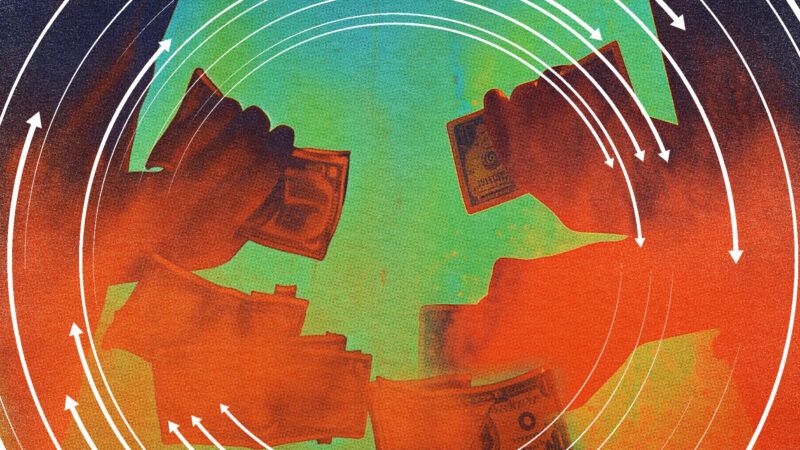20 Percent of Welfare Spending Goes to the Households Taxed To Fund It
It's not robbing Peter to pay Paul. It's more like robbing Peter to pay Peter.

About one in every five dollars that passes through the federal welfare system ends up right back where it started, according to a new report.
It's not robbing Peter to pay Paul. It's more like "robbing Peter to pay Peter," wrote the report's author, Judge Glock, director of research at the Manhattan Institute.
As the federal welfare state has grown to a point where many middle-class and even some upper-income households receive benefits, it has become more common for the same households to both pay federal taxes and collect federal transfer payments. Glock's paper shows how significant that overlap is: About 20 percent of the annual funds in the federal welfare system are simply returned to households that paid that amount in federal taxes.
And if you don't count households that are receiving Social Security—the largest federal welfare program, even though it is rarely identified as such—the percentage of welfare payments canceled out by taxes within the same year is 29 percent, Glock's research shows.
Seems like those individuals and families would be better off simply not paying so much in taxes in the first place.
"Such a system of taxing and returning the same amount of money is a pure waste," Glock wrote, "since both the taxes and transfers limit households' options, and there is a bureaucratic cost to circulating income from households to the government and back to households."
Economically, those transfers and taxes simply cancel each other out and households are left—on a balance sheet, at least—no worse off than if the money had never been taken by the government and then returned.
Glock argues that perspective is missing some important, but often overlooked, details. Dollars returned in the form of welfare transfers are often restricted—food stamps can only be used for certain purchases, for example—in ways that dollars never taxed away from someone's paycheck aren't. Or the funds might only be available at certain times of the year, as is the case with welfare delivered via refundable tax credits. There's also the cost of cycling that money through the system: paying for the IRS to collect it and various bureaucrats in other places to oversee its return.
Because of the size of the federal welfare state, that 20 percent represents a huge amount of money being returned to the same households that paid it. In 2022, those so-called netting taxes would have been equal to about $800 billion, or 3 percent of gross domestic product, Gluck calculated.
This relationship between federal taxes and the federal welfare state has little relevance for the most recent effort to expand the welfare state. Congress is currently working on a plan to expand the child tax credit program to make it fully refundable for low-income parents who do not qualify for the full amount of the tax credit under current law.
As it currently stands, a single mother with three kids who earns $10,000 annually gets a refundable tax credit (which is really a transfer payment) of $1,250 while a mother with three kids who earns $150,000 can qualify for a $6,000 tax credit, as The Washington Post noted. The proposed change wouldn't affect the wealthier parent, but would allow the poorer mother to collect $3,750 instead.
The mother earning only $10,000 is unlikely to owe any federal income taxes, so increasing transfer payments to her doesn't increase the amount of "netted" taxes. However, the wealthier mother is a good example of Glock's point in a different context. When the per-child tax credit was temporarily expanded to $3,000 per child during the pandemic, even for families earning six figures, those extra payments were delivered in the form of checks. In many cases, the federal government was simply returning funds that those same families paid in taxes throughout the year.
The same is likely to be true of any other expansion of welfare programs to middle- and upper-income households.
"A large welfare state inevitably ends up taking from the same people it supports," Glock tells Reason, "and the larger the welfare state gets, the more it will do so."


Show Comments (34)